Strategic Analysis of Regis Healthcare: Aged Care Division Performance
VerifiedAdded on 2022/08/11
|10
|2043
|106
Report
AI Summary
This report presents a strategic analysis of Regis Healthcare, a leading aged care service provider in Australia. It begins with an introduction to Regis Healthcare, its services, and its market. The discussion section includes a PEST analysis, examining the political, economic, social, and technological factors affecting the residential healthcare industry. A SWOT analysis assesses the company's strengths, weaknesses, opportunities, and threats. Furthermore, the report applies Porter's Five Forces model to analyze the competitive environment, evaluating the bargaining power of suppliers and buyers, the threat of new entrants and substitutes, and existing competition. The analysis considers the impact of government regulations, economic conditions, social values, and technological advancements on Regis Healthcare's performance and future prospects, concluding with an overview of the company's potential for growth and expansion in the market.
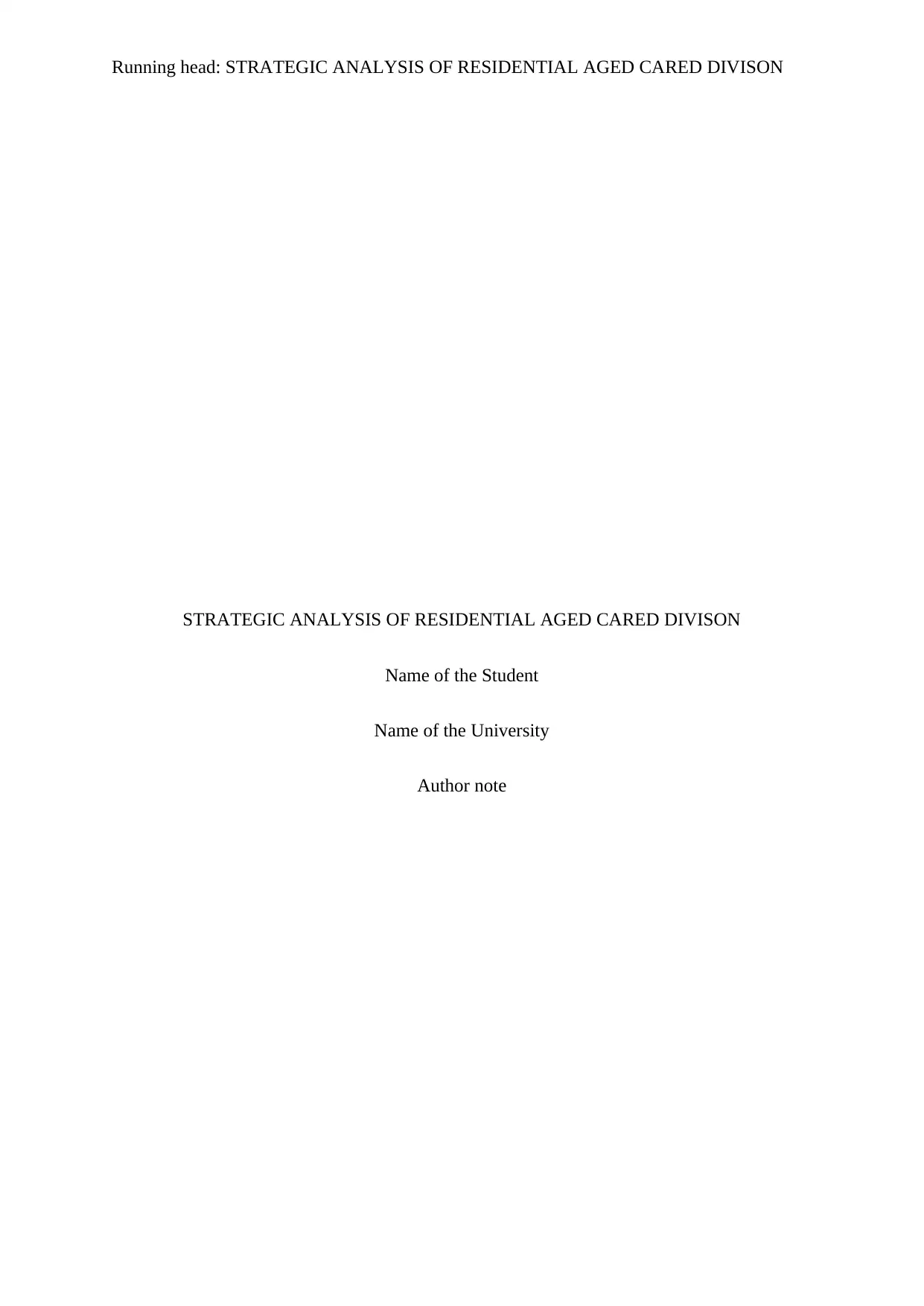
Running head: STRATEGIC ANALYSIS OF RESIDENTIAL AGED CARED DIVISON
STRATEGIC ANALYSIS OF RESIDENTIAL AGED CARED DIVISON
Name of the Student
Name of the University
Author note
STRATEGIC ANALYSIS OF RESIDENTIAL AGED CARED DIVISON
Name of the Student
Name of the University
Author note
Paraphrase This Document
Need a fresh take? Get an instant paraphrase of this document with our AI Paraphraser

1STRATEGIC ANALYSIS OF RESIDENTIAL AGED CARED DIVISON
Table of Contents
Introduction................................................................................................................................3
Discussion..................................................................................................................................3
PEST Analysis of Residential Healthcare..............................................................................3
Political..............................................................................................................................3
Economic............................................................................................................................4
Social..................................................................................................................................4
Technology.........................................................................................................................4
SWOT Analysis of the Organisation......................................................................................5
Strength..............................................................................................................................5
Weakness............................................................................................................................5
Opportunity........................................................................................................................5
Threat.................................................................................................................................6
Porter’s Five Force Model.....................................................................................................6
Bargaining Power of Supplier............................................................................................6
Bargaining Power of the Buyer..........................................................................................7
Threat of New Entrants......................................................................................................7
Threat of Substitutes..........................................................................................................7
Existing Competition in the Market...................................................................................7
Conclusion..................................................................................................................................8
Table of Contents
Introduction................................................................................................................................3
Discussion..................................................................................................................................3
PEST Analysis of Residential Healthcare..............................................................................3
Political..............................................................................................................................3
Economic............................................................................................................................4
Social..................................................................................................................................4
Technology.........................................................................................................................4
SWOT Analysis of the Organisation......................................................................................5
Strength..............................................................................................................................5
Weakness............................................................................................................................5
Opportunity........................................................................................................................5
Threat.................................................................................................................................6
Porter’s Five Force Model.....................................................................................................6
Bargaining Power of Supplier............................................................................................6
Bargaining Power of the Buyer..........................................................................................7
Threat of New Entrants......................................................................................................7
Threat of Substitutes..........................................................................................................7
Existing Competition in the Market...................................................................................7
Conclusion..................................................................................................................................8
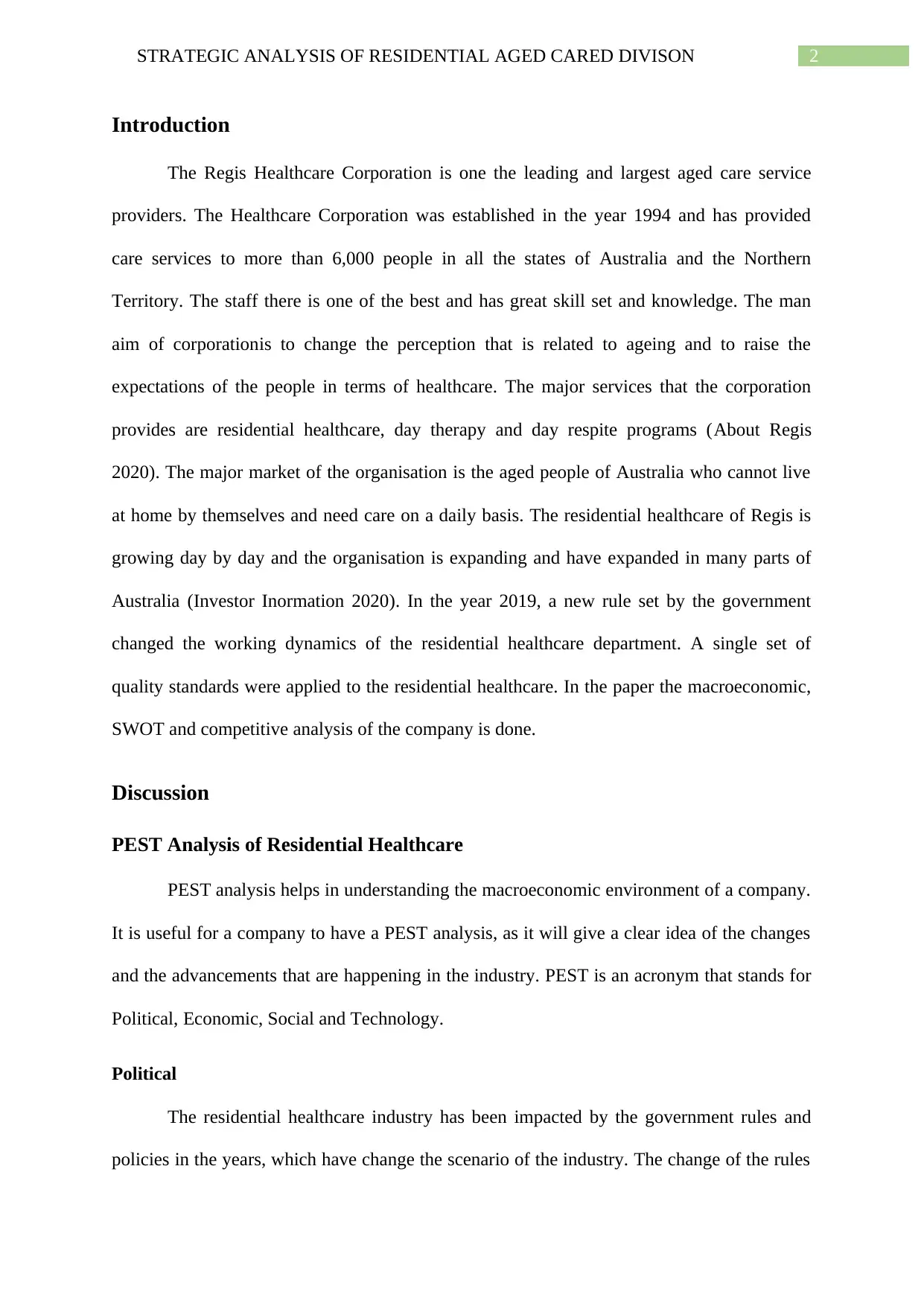
2STRATEGIC ANALYSIS OF RESIDENTIAL AGED CARED DIVISON
Introduction
The Regis Healthcare Corporation is one the leading and largest aged care service
providers. The Healthcare Corporation was established in the year 1994 and has provided
care services to more than 6,000 people in all the states of Australia and the Northern
Territory. The staff there is one of the best and has great skill set and knowledge. The man
aim of corporationis to change the perception that is related to ageing and to raise the
expectations of the people in terms of healthcare. The major services that the corporation
provides are residential healthcare, day therapy and day respite programs (About Regis
2020). The major market of the organisation is the aged people of Australia who cannot live
at home by themselves and need care on a daily basis. The residential healthcare of Regis is
growing day by day and the organisation is expanding and have expanded in many parts of
Australia (Investor Inormation 2020). In the year 2019, a new rule set by the government
changed the working dynamics of the residential healthcare department. A single set of
quality standards were applied to the residential healthcare. In the paper the macroeconomic,
SWOT and competitive analysis of the company is done.
Discussion
PEST Analysis of Residential Healthcare
PEST analysis helps in understanding the macroeconomic environment of a company.
It is useful for a company to have a PEST analysis, as it will give a clear idea of the changes
and the advancements that are happening in the industry. PEST is an acronym that stands for
Political, Economic, Social and Technology.
Political
The residential healthcare industry has been impacted by the government rules and
policies in the years, which have change the scenario of the industry. The change of the rules
Introduction
The Regis Healthcare Corporation is one the leading and largest aged care service
providers. The Healthcare Corporation was established in the year 1994 and has provided
care services to more than 6,000 people in all the states of Australia and the Northern
Territory. The staff there is one of the best and has great skill set and knowledge. The man
aim of corporationis to change the perception that is related to ageing and to raise the
expectations of the people in terms of healthcare. The major services that the corporation
provides are residential healthcare, day therapy and day respite programs (About Regis
2020). The major market of the organisation is the aged people of Australia who cannot live
at home by themselves and need care on a daily basis. The residential healthcare of Regis is
growing day by day and the organisation is expanding and have expanded in many parts of
Australia (Investor Inormation 2020). In the year 2019, a new rule set by the government
changed the working dynamics of the residential healthcare department. A single set of
quality standards were applied to the residential healthcare. In the paper the macroeconomic,
SWOT and competitive analysis of the company is done.
Discussion
PEST Analysis of Residential Healthcare
PEST analysis helps in understanding the macroeconomic environment of a company.
It is useful for a company to have a PEST analysis, as it will give a clear idea of the changes
and the advancements that are happening in the industry. PEST is an acronym that stands for
Political, Economic, Social and Technology.
Political
The residential healthcare industry has been impacted by the government rules and
policies in the years, which have change the scenario of the industry. The change of the rules
⊘ This is a preview!⊘
Do you want full access?
Subscribe today to unlock all pages.

Trusted by 1+ million students worldwide
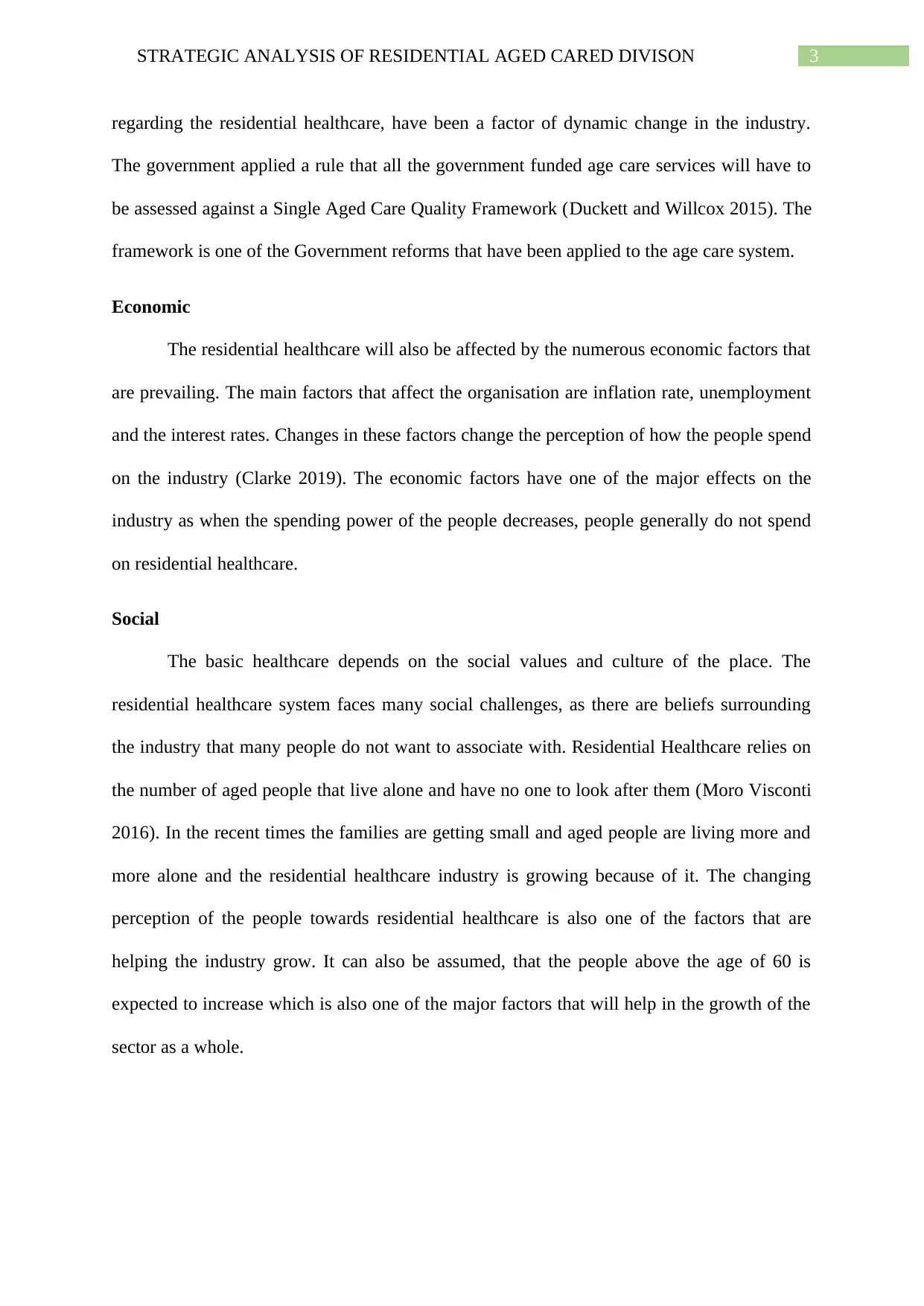
3STRATEGIC ANALYSIS OF RESIDENTIAL AGED CARED DIVISON
regarding the residential healthcare, have been a factor of dynamic change in the industry.
The government applied a rule that all the government funded age care services will have to
be assessed against a Single Aged Care Quality Framework (Duckett and Willcox 2015). The
framework is one of the Government reforms that have been applied to the age care system.
Economic
The residential healthcare will also be affected by the numerous economic factors that
are prevailing. The main factors that affect the organisation are inflation rate, unemployment
and the interest rates. Changes in these factors change the perception of how the people spend
on the industry (Clarke 2019). The economic factors have one of the major effects on the
industry as when the spending power of the people decreases, people generally do not spend
on residential healthcare.
Social
The basic healthcare depends on the social values and culture of the place. The
residential healthcare system faces many social challenges, as there are beliefs surrounding
the industry that many people do not want to associate with. Residential Healthcare relies on
the number of aged people that live alone and have no one to look after them (Moro Visconti
2016). In the recent times the families are getting small and aged people are living more and
more alone and the residential healthcare industry is growing because of it. The changing
perception of the people towards residential healthcare is also one of the factors that are
helping the industry grow. It can also be assumed, that the people above the age of 60 is
expected to increase which is also one of the major factors that will help in the growth of the
sector as a whole.
regarding the residential healthcare, have been a factor of dynamic change in the industry.
The government applied a rule that all the government funded age care services will have to
be assessed against a Single Aged Care Quality Framework (Duckett and Willcox 2015). The
framework is one of the Government reforms that have been applied to the age care system.
Economic
The residential healthcare will also be affected by the numerous economic factors that
are prevailing. The main factors that affect the organisation are inflation rate, unemployment
and the interest rates. Changes in these factors change the perception of how the people spend
on the industry (Clarke 2019). The economic factors have one of the major effects on the
industry as when the spending power of the people decreases, people generally do not spend
on residential healthcare.
Social
The basic healthcare depends on the social values and culture of the place. The
residential healthcare system faces many social challenges, as there are beliefs surrounding
the industry that many people do not want to associate with. Residential Healthcare relies on
the number of aged people that live alone and have no one to look after them (Moro Visconti
2016). In the recent times the families are getting small and aged people are living more and
more alone and the residential healthcare industry is growing because of it. The changing
perception of the people towards residential healthcare is also one of the factors that are
helping the industry grow. It can also be assumed, that the people above the age of 60 is
expected to increase which is also one of the major factors that will help in the growth of the
sector as a whole.
Paraphrase This Document
Need a fresh take? Get an instant paraphrase of this document with our AI Paraphraser
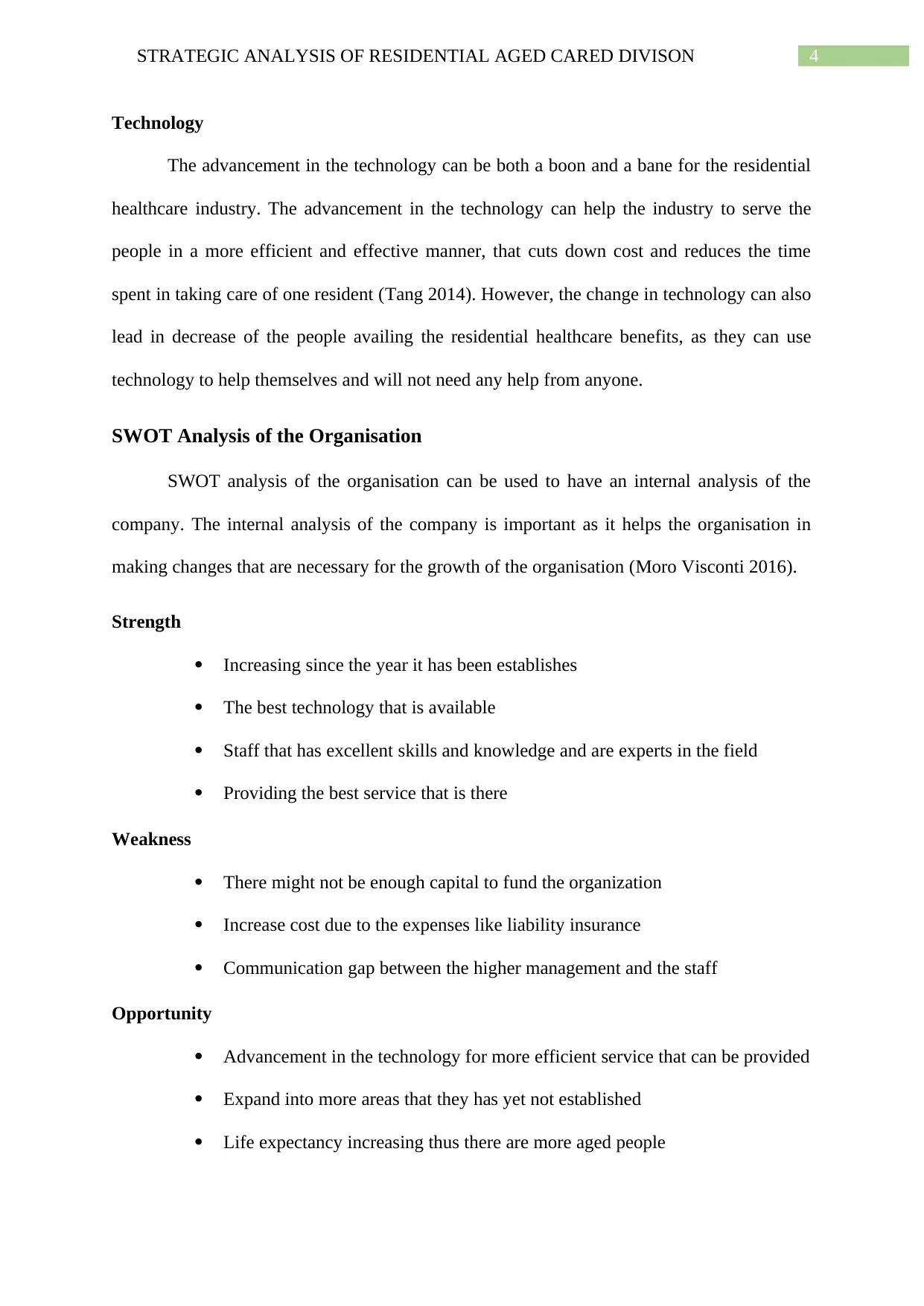
4STRATEGIC ANALYSIS OF RESIDENTIAL AGED CARED DIVISON
Technology
The advancement in the technology can be both a boon and a bane for the residential
healthcare industry. The advancement in the technology can help the industry to serve the
people in a more efficient and effective manner, that cuts down cost and reduces the time
spent in taking care of one resident (Tang 2014). However, the change in technology can also
lead in decrease of the people availing the residential healthcare benefits, as they can use
technology to help themselves and will not need any help from anyone.
SWOT Analysis of the Organisation
SWOT analysis of the organisation can be used to have an internal analysis of the
company. The internal analysis of the company is important as it helps the organisation in
making changes that are necessary for the growth of the organisation (Moro Visconti 2016).
Strength
Increasing since the year it has been establishes
The best technology that is available
Staff that has excellent skills and knowledge and are experts in the field
Providing the best service that is there
Weakness
There might not be enough capital to fund the organization
Increase cost due to the expenses like liability insurance
Communication gap between the higher management and the staff
Opportunity
Advancement in the technology for more efficient service that can be provided
Expand into more areas that they has yet not established
Life expectancy increasing thus there are more aged people
Technology
The advancement in the technology can be both a boon and a bane for the residential
healthcare industry. The advancement in the technology can help the industry to serve the
people in a more efficient and effective manner, that cuts down cost and reduces the time
spent in taking care of one resident (Tang 2014). However, the change in technology can also
lead in decrease of the people availing the residential healthcare benefits, as they can use
technology to help themselves and will not need any help from anyone.
SWOT Analysis of the Organisation
SWOT analysis of the organisation can be used to have an internal analysis of the
company. The internal analysis of the company is important as it helps the organisation in
making changes that are necessary for the growth of the organisation (Moro Visconti 2016).
Strength
Increasing since the year it has been establishes
The best technology that is available
Staff that has excellent skills and knowledge and are experts in the field
Providing the best service that is there
Weakness
There might not be enough capital to fund the organization
Increase cost due to the expenses like liability insurance
Communication gap between the higher management and the staff
Opportunity
Advancement in the technology for more efficient service that can be provided
Expand into more areas that they has yet not established
Life expectancy increasing thus there are more aged people
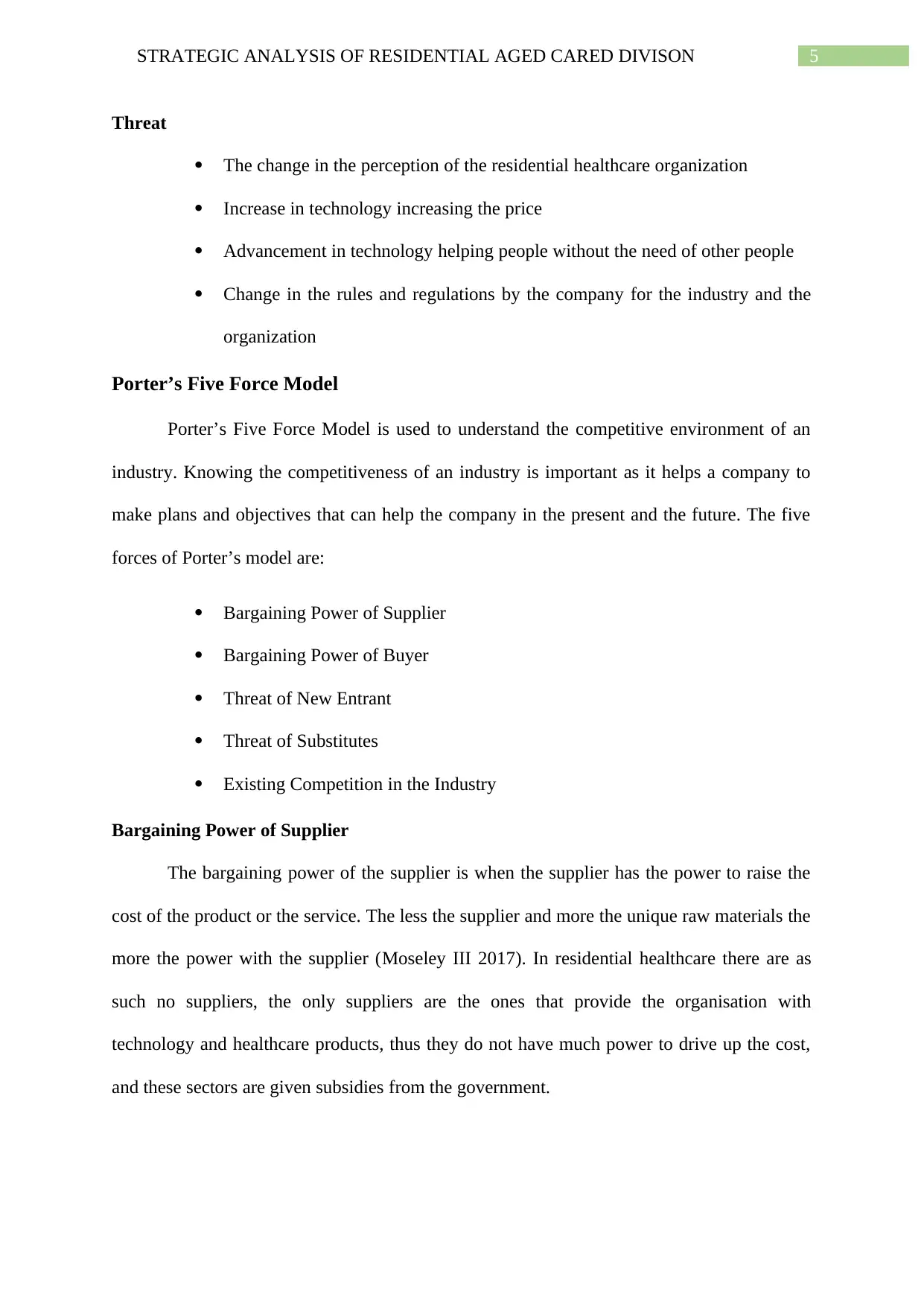
5STRATEGIC ANALYSIS OF RESIDENTIAL AGED CARED DIVISON
Threat
The change in the perception of the residential healthcare organization
Increase in technology increasing the price
Advancement in technology helping people without the need of other people
Change in the rules and regulations by the company for the industry and the
organization
Porter’s Five Force Model
Porter’s Five Force Model is used to understand the competitive environment of an
industry. Knowing the competitiveness of an industry is important as it helps a company to
make plans and objectives that can help the company in the present and the future. The five
forces of Porter’s model are:
Bargaining Power of Supplier
Bargaining Power of Buyer
Threat of New Entrant
Threat of Substitutes
Existing Competition in the Industry
Bargaining Power of Supplier
The bargaining power of the supplier is when the supplier has the power to raise the
cost of the product or the service. The less the supplier and more the unique raw materials the
more the power with the supplier (Moseley III 2017). In residential healthcare there are as
such no suppliers, the only suppliers are the ones that provide the organisation with
technology and healthcare products, thus they do not have much power to drive up the cost,
and these sectors are given subsidies from the government.
Threat
The change in the perception of the residential healthcare organization
Increase in technology increasing the price
Advancement in technology helping people without the need of other people
Change in the rules and regulations by the company for the industry and the
organization
Porter’s Five Force Model
Porter’s Five Force Model is used to understand the competitive environment of an
industry. Knowing the competitiveness of an industry is important as it helps a company to
make plans and objectives that can help the company in the present and the future. The five
forces of Porter’s model are:
Bargaining Power of Supplier
Bargaining Power of Buyer
Threat of New Entrant
Threat of Substitutes
Existing Competition in the Industry
Bargaining Power of Supplier
The bargaining power of the supplier is when the supplier has the power to raise the
cost of the product or the service. The less the supplier and more the unique raw materials the
more the power with the supplier (Moseley III 2017). In residential healthcare there are as
such no suppliers, the only suppliers are the ones that provide the organisation with
technology and healthcare products, thus they do not have much power to drive up the cost,
and these sectors are given subsidies from the government.
⊘ This is a preview!⊘
Do you want full access?
Subscribe today to unlock all pages.

Trusted by 1+ million students worldwide

6STRATEGIC ANALYSIS OF RESIDENTIAL AGED CARED DIVISON
Bargaining Power of the Buyer
The buyers or the consumers, if large and significant have the power to reduce the
cost of the product or the service. In the residential healthcare industry, the buyers are usually
the people that are in need of the service and need the help of the healthcare experts to take
care of themselves (Maresova and Kuca 2014). These people are usually the ones that live
alone and have enough money that they can spend on gaining medical help.
Threat of New Entrants
The threat of new entrants in the residential healthcare is not that high, as people
prefer the place from they are taking service. There is a trust between the consumers and the
healthcare providers that make the consumers not want to switch to the new entrants that are
coming in the market, and the regulations to enter the market are also tight, which can make
it difficult for the new organisations to enter into the industry (Montgomery and Oladapo
2014).
Threat of Substitutes
The threat of substitutes in the residential healthcare industry is huge as there are
many times that the people do not wish to indulge themselves in the residential healthcare
services, however they just want a day time or night time service depending on their need.
The advancement in the technology in the other healthcare is also a major threat as a
substitute for the residential healthcare industry (Austin, Bentkover and Chait 2016). The
residential healthcare of Regis is one of the best in Australia, thus people tend to not to try the
substitutes that are there.
Existing Competition in the Market
There are many competitors that are there in the market for the residential healthcare
organisation. The company must have better services and technologies for the consumers to
Bargaining Power of the Buyer
The buyers or the consumers, if large and significant have the power to reduce the
cost of the product or the service. In the residential healthcare industry, the buyers are usually
the people that are in need of the service and need the help of the healthcare experts to take
care of themselves (Maresova and Kuca 2014). These people are usually the ones that live
alone and have enough money that they can spend on gaining medical help.
Threat of New Entrants
The threat of new entrants in the residential healthcare is not that high, as people
prefer the place from they are taking service. There is a trust between the consumers and the
healthcare providers that make the consumers not want to switch to the new entrants that are
coming in the market, and the regulations to enter the market are also tight, which can make
it difficult for the new organisations to enter into the industry (Montgomery and Oladapo
2014).
Threat of Substitutes
The threat of substitutes in the residential healthcare industry is huge as there are
many times that the people do not wish to indulge themselves in the residential healthcare
services, however they just want a day time or night time service depending on their need.
The advancement in the technology in the other healthcare is also a major threat as a
substitute for the residential healthcare industry (Austin, Bentkover and Chait 2016). The
residential healthcare of Regis is one of the best in Australia, thus people tend to not to try the
substitutes that are there.
Existing Competition in the Market
There are many competitors that are there in the market for the residential healthcare
organisation. The company must have better services and technologies for the consumers to
Paraphrase This Document
Need a fresh take? Get an instant paraphrase of this document with our AI Paraphraser

7STRATEGIC ANALYSIS OF RESIDENTIAL AGED CARED DIVISON
choose their service, rather than the competitors (Moseley III 2017). The organisation is one
of the best in the residential healthcare industry and has seen tremendous growth in the past
years. Though there is, a competition in the industry the organisation’s motive is to provide
the best healthcare in the country.
Conclusion
It can be concluded from the discussion done above that the organisation is one of the
best in the country. The organisation has a huge potential to grow and expand themselves in
the market. There are many opportunities for the organisation that if utilised perfectly can
become one of the strengths of the company. The organisation is also benefitting from the
advancement in the technology as they can provide the people in a more efficient manner.
The macroeconomic environment of the organisation has also been discussed in the paper and
how the organisation is affected by the Political, Economic, Social and Technological factors.
The SWOT analysis of the organisation is also done to understand where the company is
doing well and where it can improve more. The competitive analysis of the company using
the Porter’s Five Force Model has also been done for the organisation.
choose their service, rather than the competitors (Moseley III 2017). The organisation is one
of the best in the residential healthcare industry and has seen tremendous growth in the past
years. Though there is, a competition in the industry the organisation’s motive is to provide
the best healthcare in the country.
Conclusion
It can be concluded from the discussion done above that the organisation is one of the
best in the country. The organisation has a huge potential to grow and expand themselves in
the market. There are many opportunities for the organisation that if utilised perfectly can
become one of the strengths of the company. The organisation is also benefitting from the
advancement in the technology as they can provide the people in a more efficient manner.
The macroeconomic environment of the organisation has also been discussed in the paper and
how the organisation is affected by the Political, Economic, Social and Technological factors.
The SWOT analysis of the organisation is also done to understand where the company is
doing well and where it can improve more. The competitive analysis of the company using
the Porter’s Five Force Model has also been done for the organisation.
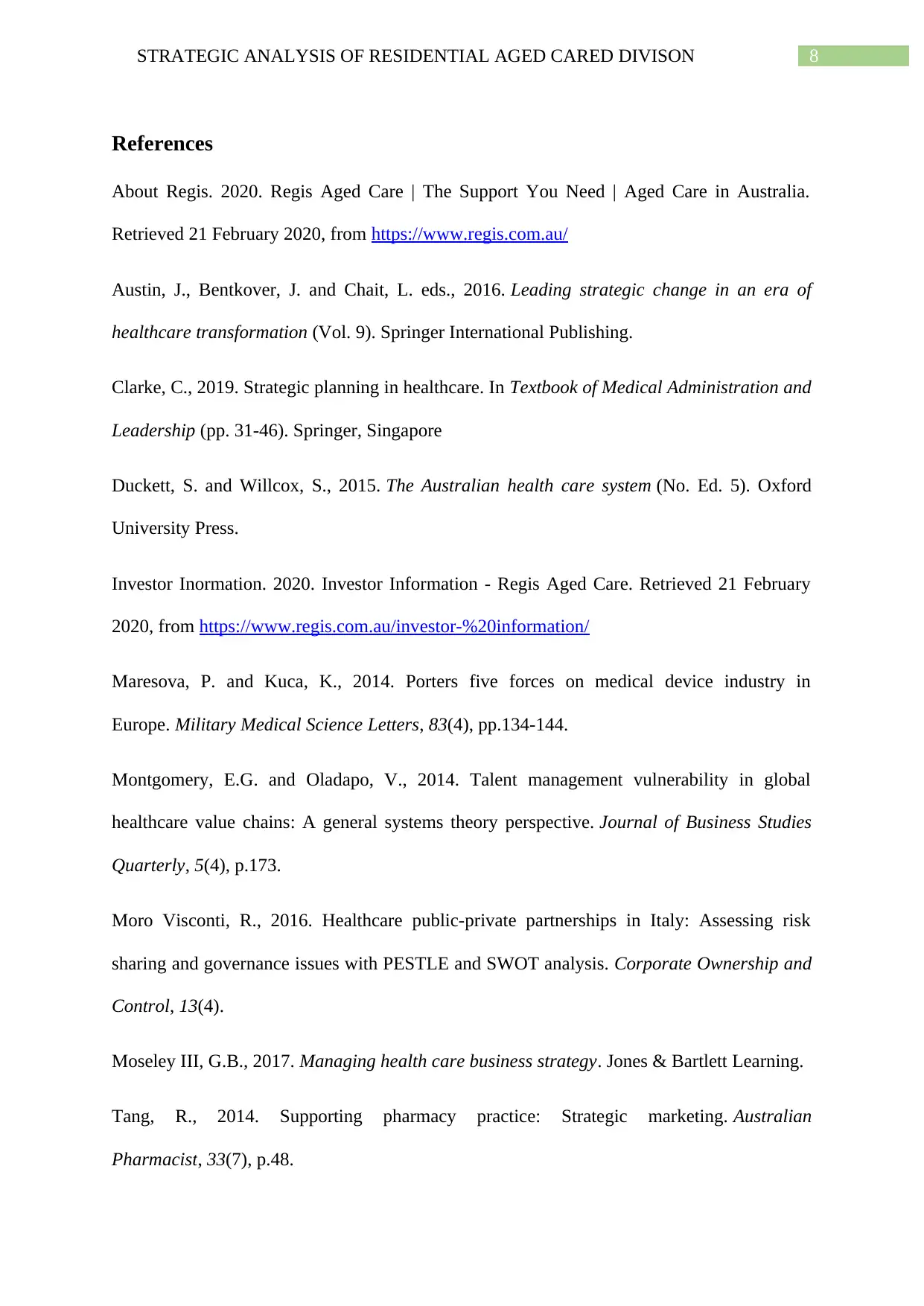
8STRATEGIC ANALYSIS OF RESIDENTIAL AGED CARED DIVISON
References
About Regis. 2020. Regis Aged Care | The Support You Need | Aged Care in Australia.
Retrieved 21 February 2020, from https://www.regis.com.au/
Austin, J., Bentkover, J. and Chait, L. eds., 2016. Leading strategic change in an era of
healthcare transformation (Vol. 9). Springer International Publishing.
Clarke, C., 2019. Strategic planning in healthcare. In Textbook of Medical Administration and
Leadership (pp. 31-46). Springer, Singapore
Duckett, S. and Willcox, S., 2015. The Australian health care system (No. Ed. 5). Oxford
University Press.
Investor Inormation. 2020. Investor Information - Regis Aged Care. Retrieved 21 February
2020, from https://www.regis.com.au/investor-%20information/
Maresova, P. and Kuca, K., 2014. Porters five forces on medical device industry in
Europe. Military Medical Science Letters, 83(4), pp.134-144.
Montgomery, E.G. and Oladapo, V., 2014. Talent management vulnerability in global
healthcare value chains: A general systems theory perspective. Journal of Business Studies
Quarterly, 5(4), p.173.
Moro Visconti, R., 2016. Healthcare public-private partnerships in Italy: Assessing risk
sharing and governance issues with PESTLE and SWOT analysis. Corporate Ownership and
Control, 13(4).
Moseley III, G.B., 2017. Managing health care business strategy. Jones & Bartlett Learning.
Tang, R., 2014. Supporting pharmacy practice: Strategic marketing. Australian
Pharmacist, 33(7), p.48.
References
About Regis. 2020. Regis Aged Care | The Support You Need | Aged Care in Australia.
Retrieved 21 February 2020, from https://www.regis.com.au/
Austin, J., Bentkover, J. and Chait, L. eds., 2016. Leading strategic change in an era of
healthcare transformation (Vol. 9). Springer International Publishing.
Clarke, C., 2019. Strategic planning in healthcare. In Textbook of Medical Administration and
Leadership (pp. 31-46). Springer, Singapore
Duckett, S. and Willcox, S., 2015. The Australian health care system (No. Ed. 5). Oxford
University Press.
Investor Inormation. 2020. Investor Information - Regis Aged Care. Retrieved 21 February
2020, from https://www.regis.com.au/investor-%20information/
Maresova, P. and Kuca, K., 2014. Porters five forces on medical device industry in
Europe. Military Medical Science Letters, 83(4), pp.134-144.
Montgomery, E.G. and Oladapo, V., 2014. Talent management vulnerability in global
healthcare value chains: A general systems theory perspective. Journal of Business Studies
Quarterly, 5(4), p.173.
Moro Visconti, R., 2016. Healthcare public-private partnerships in Italy: Assessing risk
sharing and governance issues with PESTLE and SWOT analysis. Corporate Ownership and
Control, 13(4).
Moseley III, G.B., 2017. Managing health care business strategy. Jones & Bartlett Learning.
Tang, R., 2014. Supporting pharmacy practice: Strategic marketing. Australian
Pharmacist, 33(7), p.48.
⊘ This is a preview!⊘
Do you want full access?
Subscribe today to unlock all pages.

Trusted by 1+ million students worldwide
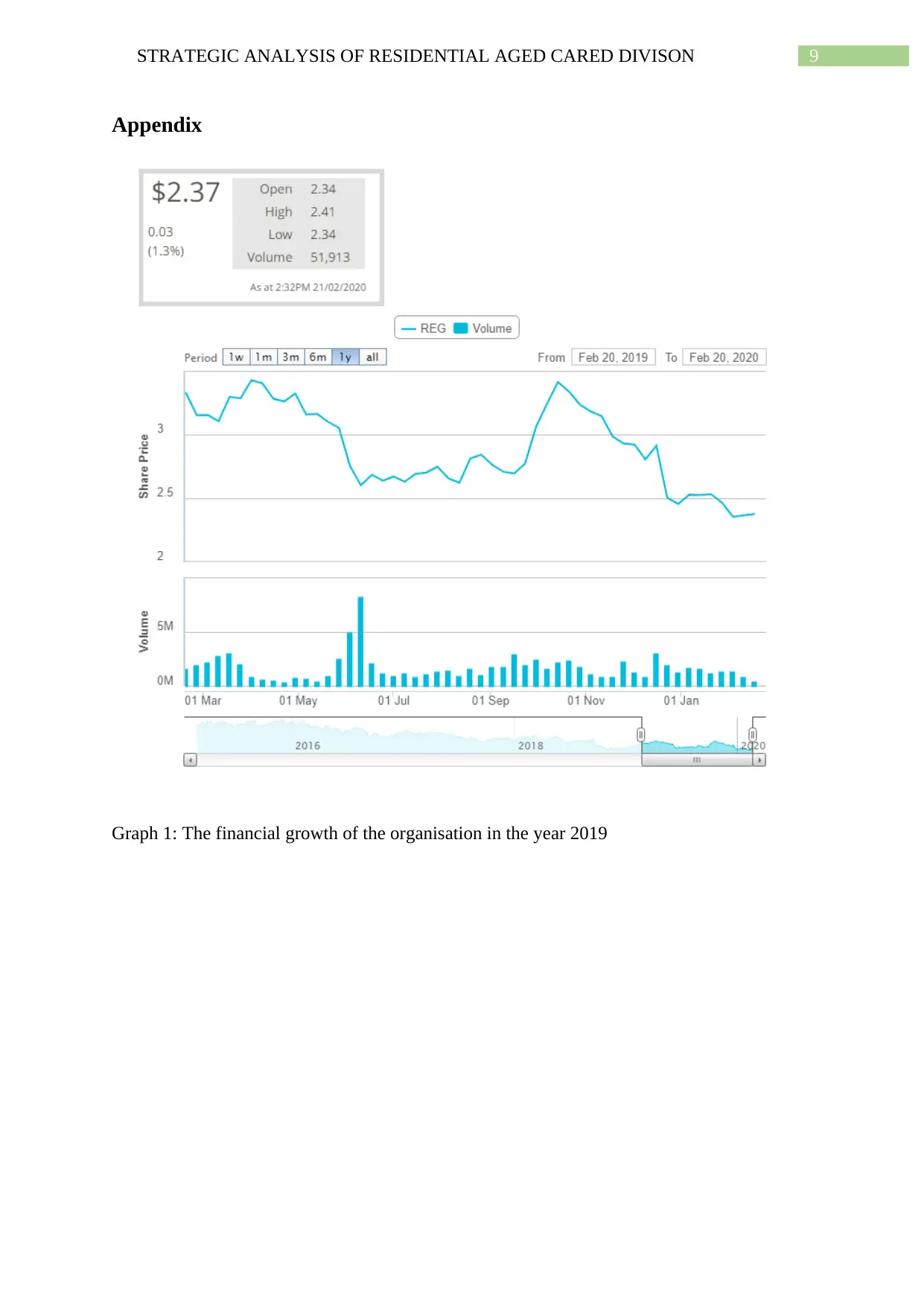
9STRATEGIC ANALYSIS OF RESIDENTIAL AGED CARED DIVISON
Appendix
Graph 1: The financial growth of the organisation in the year 2019
Appendix
Graph 1: The financial growth of the organisation in the year 2019
1 out of 10
Related Documents
Your All-in-One AI-Powered Toolkit for Academic Success.
+13062052269
info@desklib.com
Available 24*7 on WhatsApp / Email
![[object Object]](/_next/static/media/star-bottom.7253800d.svg)
Unlock your academic potential
Copyright © 2020–2025 A2Z Services. All Rights Reserved. Developed and managed by ZUCOL.





